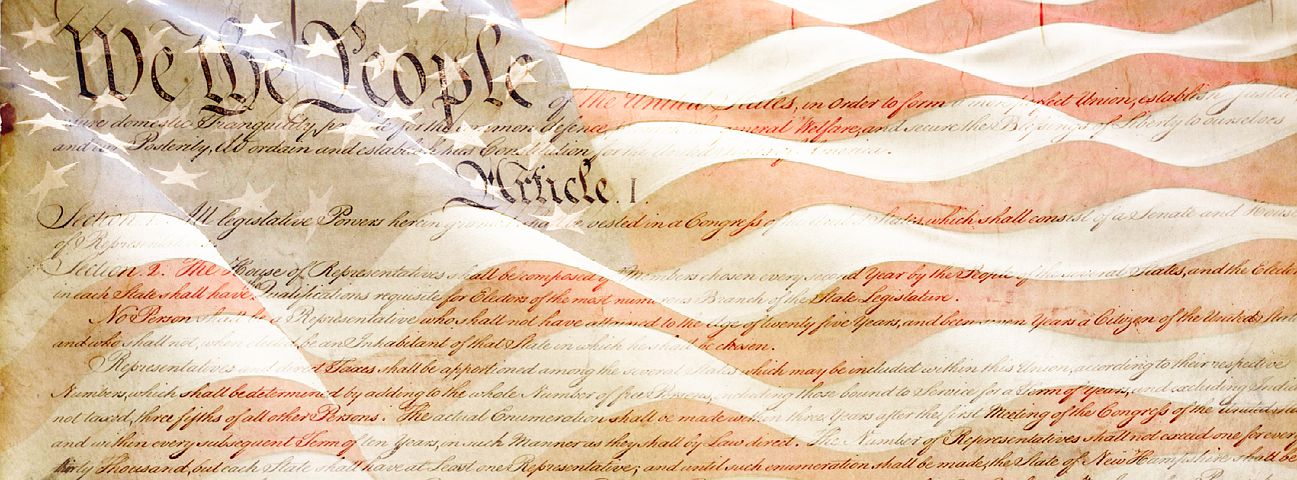
The Bible and the Constitution:
Of Monkeys, Babies and Original Intent
Larry W. Caldwell
In 1925, on Day 7 of the infamous “Scopes Monkey Trial” (The State of Tennessee v. John Thomas Scopes), defense attorney Clarence Darrow interrogated prosecuting attorney William Jennings Bryan on the witness stand. His purpose was to discredit Bryan’s (and many Protestants’) view that the original author of Genesis understood the six days of creation to be six, literal days:
Darrow: You have given considerable study to the Bible, haven’t you, Mr. Bryan?
Bryan: Yes sir, I have tried to.
Darrow: Then you have made a general study of it?
Bryan: Yes, I have; I have studied the Bible for about fifty years …
Darrow: You claim that everything in the Bible should be literally interpreted?
Bryan: I believe that everything in the Bible should be accepted as it is given there …
Although Darrow and Bryan didn’t use terms like originalism and textualism, their subsequent interaction is enlightening. This is especially thanks to Bryan’s understanding that while we do not know what the original writers of the Bible thought, they still wrote biblical texts as fact, without expressing their own opinion:
Darrow: The Bible says Joshua commanded the sun to stand still [Joshua 10:12-14] for the purpose of lengthening the day, doesn’t it, and you believe it?
Bryan: I do.
Darrow: Do you believe at that time the entire sun went around the earth?
Bryan: No, I believe that the earth goes around the sun.
Darrow: Do you believe that the men who wrote it thought that the day could be lengthened or that the sun could be stopped?
Bryan: I don’t know what they thought.
Darrow: You don’t know?
Bryan: I think they wrote the fact without expressing their own thoughts.
Fast forward almost one hundred years. On Day 2 of her Senate confirmation hearings, Judge Amy Coney Barrett was questioned by the chairman of the Judiciary Committee, Senator Lindsey Graham:
Graham: You said you’re an originalist. Is that true?
Barrett: Yes.
Graham: What does that mean, in English? …
Barrett: In English. Okay. So in English, that means that I interpret the Constitution as a law, that I interpret its text as text, and I understand it to have the meaning that it had at the time people ratified it. So that meaning doesn’t change over time and it’s not up to me to update it or infuse my own policy views into it.
Graham: So in other words, you’re bound by the people who wrote it at the time they wrote it. That keeps you from substituting your judgment for theirs. Is that correct?
Barrett: Yeah.
The Quandary of Original Intent
Specific interpretations of a text — whether by literalists interpreting the Bible like Bryan did, or by originalists/textualists interpreting the Constitution like Barrett does — will always be met with differing interpretations from other interpreters. And that is the rub, whether people are interpreting the Bible or the Constitution. While most will agree that a text has a meaning that carries through time, differing interpretations will, for the most part, be based on the very beginning of the specific text’s life: what did the original author mean or intend? Today this concept of “original intent” raises numerous questions for both the Bible and the Constitution.
In relation to biblical interpretations, these questions include:
- When speaking of original intent, are we referencing the original intent of the actual writers or the original intent of the canonical communities who eventually claimed specific texts as authoritative?
- Which translation of the Bible is the most authoritative for best understanding the original intent: English, Greek (New Testament), Hebrew or Aramaic (Old Testament)?
- Which text and version of the Old and New Testaments are the most authoritative and, therefore, allow the original intent to best be inferred?
- What of the nature of language itself and the grammatical differences, say, in the use of the imperative vs. the indicative verb in Paul’s writings?
In relation to interpreting the Constitution, important questions include:
- Does “original intent” refer to the intentions of the Constitution’s writers, or to those of the states that ratified it?
- Does the phrase, “We the people,” imply that non-English speaking citizens of the United States need the Constitution translated into their own native language for them to truly understand the original intent?
- How did the “ebb and flow of the tide” understanding of maritime geography in the original 13 colonies affect the Constitution’s interpretation when the Great Lakes and other large, navigable rivers were later added to the United States (as seen in Propeller Genesee Chief v. Fitzhugh)?
- What of the nature of language itself and whether the grammar of the text is mandatory (i.e., the use of the word “shall” in Article 3, Section 1) or open to phrase-by-phrase interpretation (i.e., the passage on “a well regulated Militia” found in the Second Amendment)?
Several related questions also arise: Can we really know the original intent of the authors, whether they be the writers of the 66 books of the Bible or the 55 delegates who attended the Constitutional Convention? If knowing the original intent of the authors is indeed possible, then why are there differing interpretations of a text? And just how, literally, do we interpret a text and when do we do so?

Most people who interpret a biblical text seem, almost intuitively, to know when that text should be interpreted literally and when not; for example, Jesus’ admonition to his disciples: “if your eye causes you to sin, gouge it out” (Matthew 18:9, ESV). Certainly, Jesus did not mean for this saying to be taken literally; there are not a lot of self-inflicted, blind Christians in the world! But with other places in Scripture it is much less clear what the original author intended. Here, intuition is of no help. For example, David’s implication in Psalm 139:13-14a (NIV): “For you created my inmost being; you knit me together in my mother’s womb. I praise you because I am fearfully and wonderfully made.” Is David here speaking in general terms about God’s role in David’s own physical development as an unborn child, or is he saying that all unborn babies from conception are fully human beings, with all the legal rights and privileges that go along with such an assertion? Just what did the original author intend?
The recent Supreme Court decision regarding Roe v. Wade and Casey (Dobbs v. Jackson Women’s Health), makes such questions particularly relevant. Justice Alito, in delivering the opinion of the Court, seemed to imply an originalist and literal interpretation of the Constitution when he wrote: “We hold that Roe and Casey must be overruled. The Constitution makes no reference to abortion, and no such right is implicitly protected by any constitutional provision, including the one on which the defenders of Roe and Casey now chiefly rely — the Due Process Clause of the Fourteenth Amendment… It is time to heed the Constitution and return the issue of abortion to the people’s elected representatives.”
Of course, not all the justices agreed with the majority’s interpretation. Their minority arguments seemed to go beyond the text itself and relied more on pragmatism and precedent. In their dissent, Justices Breyer, Sotomayor, and Kagan responded: “Yesterday, the Constitution guaranteed that a woman confronted with an unplanned pregnancy could (within reasonable limits) make her own decision about whether to bear a child, with all the life-transforming consequences that act involves. And in thus safeguarding each woman’s reproductive freedom, the Constitution also protected ‘[t]he ability of women to participate equally in [this Nation’s] economic and social life.’ [Casey, 505 U. S., at 856.] But no longer.”
Common Themes of Interpretation
Good Bible interpretations typically follow a two-step approach. The first step is concerned with the question: What did the biblical text mean when it was first given by its original writer/speaker? The answer to this question is ascertained through an analysis of the original context of the Scripture passage. Most analysts use the tools of biblical criticism, which study the textual, grammatical, and historical questions of the Old and New Testaments. This first step stresses that a biblical text must be understood in light of at least three factors: 1) the syntax and meaning of the words used; 2) the context in which the words are found; and 3) the underlying historical setting behind the words. This step underscores the importance of letting the original text speak for itself first, before other voices are heard.

Next, the interpreter attempts to answer the question: How is that Bible passage to be best interpreted for today? In this second step the interpreter applies the results of the first step to the audience that the interpreter is ministering with, usually being careful to make sure that the second step closely approximates the results of the first step. Nevertheless, even those Bible interpreters who closely use the tools of historical criticism in the first step may differ radically in their applications for their present contexts in the second step. Perhaps that is one reason why there are over 1,000 different denominations today.
Though I am not a legal expert in Constitutional interpretation, from my perspective, it seems that any judge, whether they be originalists, textualists, pragmatists, or some combination thereof, should pay attention to several of the aspects referred to above when looking at the Constitution. They should be concerned with both step one: the syntax and meaning of its words; the context of those words in the document; and the historical context concerning when those rules were drafted and ratified; as well as step two: the desire to best interpret those words for the American people today. To neglect these steps may mean to abandon the Constitution’s ability to speak for itself first, and thereby, jettison the imposed will of the writers/ratifiers on future generations. However, as is readily seen in today’s current events, as with Bible interpreters so too with judges: not all judges will agree on the Constitution’s interpretation.
A Way Forward
So who’s interpretation is correct, whether referencing the Bible or the Constitution? What is often lost in such discussions of original intent is the influence that one’s worldview has on the interpreter, whether they are a biblical exegete or a judge. Are we to truly believe that Bryan’s views on the literal interpretation of the Bible were not shaped by the conservative Protestantism in which he was raised? Likewise, can we seriously sidestep the possibility that Justice Barrett has been influenced by her charismatic Catholic background? All Bible interpreters, as well as all Constitution interpreters, are affected by their culture and history; in a nutshell, their worldview. No one interprets a text in a vacuum. So Scopes was no doubt influenced by Bryan’s literal views of the Bible. Likewise, Dobbs was no doubt influenced by Barrett’s Catholic views.
At the same time, we need to see that literal interpretations, by themselves, may prove to be tricky. In chapter 4 of my own textbook on Bible interpretation, I argue that Bible interpreters face two problems in relation to original intent. First, the original context is very different from our context today. Sometimes we understand what a particular Bible passage meant to the original writer and his original audience. But then we realize that their original situation and culture is so very different from our own that the Bible passage just does not seem to be relevant today. Second, the original context is unknown to us. Sometimes, though more rarely, it is difficult to understand what a particular Bible passage meant either to the original writer or to his original audience. There is just not enough information about the original context to reach a definite conclusion. These two problems face Constitutional interpreters as well.

What is the answer to these problems of original intent? It is really quite simple: look for the general principle behind what the original author intended in every Bible passage. That way, in general terms, we can better ascertain what the original author intended. Thus, Jesus’ admonition to gouge out one’s eye must be seen in light of the general principle that Jesus, here in his hyperbolic statement, is trying to get the following point across to his disciples: sin is serious and should be avoided at all costs. Likewise, David in Psalm 139 is speaking, in general terms, of the wonderfulness of making an unborn child and God’s direct role in the process. As a result, any serious attempt at ascertaining a Bible passage’s interpretation must take into account the general principle behind the words, since it is the general principle that will more fully guide us in the application process of the second step. What holds true for Bible interpreters holds true for Constitutional interpreters as well.
Fortunately, Constitutional interpreters have a lot more corroborating evidence than Bible interpreters do when it comes to understanding the general principles behind specific texts. The Bible, as an ancient document written some 2,000 to 4,000 years ago, does not have a lot of ancient documentary evidence that give much insight into specific texts. Such is not the case with the Constitution. Today we have ready access to many existing documents that help us better understand the general principles underlying what the writers/ratifiers originally wrote. We have a great deal of material from the debates surrounding the adoption of the Constitution, chief of which are the Federalist Papers. We have state constitutions from the same period often with similar wording. We can trace the progress of relevant legislation passed by the states and congress that display the limits of Constitutional law. Furthermore, we have the intellectual traditions behind the founding of our republic displayed in English common law and the writings of the founders. All of these give further insight into the general principles that lie behind the Constitution’s text and the original intent of the writers/ratifiers.
Of course, not all general principles are correct. General principles are also interpretations and there will be considerable debate concerning them. At the same time, looking for the general principle, whether in the text of the Bible or the text of the Constitution, will go a long way toward helping us better understand the text’s original intent, as well as the resulting applications for both our own lives and our country. ♦

Larry W. Caldwell is Chief Academic Officer and Dean, and Professor of Bible Interpretation and Intercultural Studies, at Kairos University/Sioux Falls Seminary. His primary areas of interest are ethnohermeneutics, cultural exegesis, and other intercultural and cross-cultural issues related to Bible interpretation. His most recent book is Doing Bible Interpretation.
Recommended Citation
Caldwell, Larry W. “The Bible and the Constitution: Of Monkeys, Babies and Original Intent”. Canopy Forum, October 5, 2022. https://canopyforum.org/2022/10/05/the-bible-and-the-constitution-of-monkeys-babies-and-original-intent/

